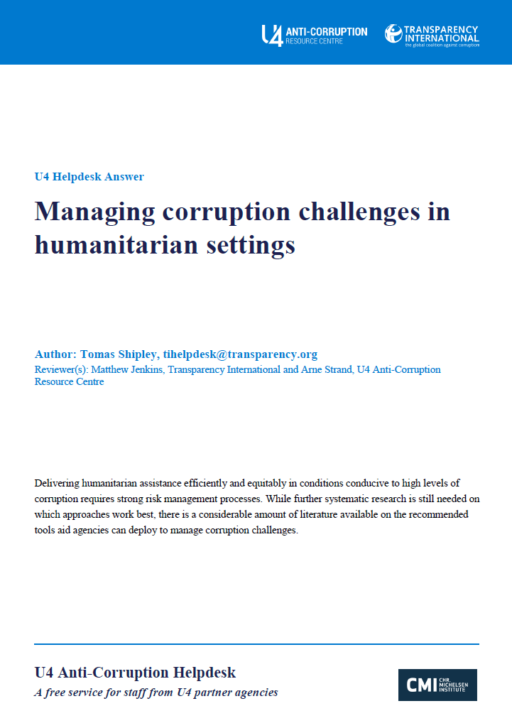
This Anti-Corruption Helpdesk brief was produced in response to a query from a U4 Partner Agency. The U4 Helpdesk is operated by Transparency International in collaboration with the U4 Anti-Corruption Resource Centre based at the Chr. Michelsen Institute.
Query
We would like to gain a better understanding of how corruption works in humanitarian settings, including an overview of the principal challenges and how these might be prevented and managed. We would further like to assess the level of evidence on what works and what does not and the lessons which have been learned from humanitarian crises to date.
Summary
Delivering humanitarian assistance efficiently and equitably in conditions conducive to high levels of corruption requires strong risk management processes. While further systematic research is still needed on which approaches work best, there is a considerable amount of literature available on the recommended tools aid agencies can deploy to manage corruption challenges.
Main points
- The high level of vulnerability in the humanitarian sector to corruption challenges is increasingly recognised. The level of discussion and openness around the topic is gradually improving.
- Corruption challenges in humanitarian settings vary significantly according to contextual conditions. Risks are present across the programme cycle with corruption taking diverse forms. These are not limited to financial forms of corruption and include sextortion, nepotism and political interference.
- There are existing detailed resource texts on preventing and managing corruption risks (see in particular Transparency International 2014 and 2017) which provide various tools in these areas. This briefing summarises the key measures.
- There is also a growing number of country case studies which provide valuable examples of lessons learned from humanitarian crises.
- Nevertheless, there has been little systematic evaluation of which anti-corruption measures have proven to be the most effective. This is a gap in the literature where further research is needed
Contents
- Corruption challenges in humanitarian settings
- Preventing corruption risks in humanitarian settings
- Managing corruption risks in humanitarian settings
- The evidence on which anti-corruption measures work
- Examples of lessons learned from humanitarian crises
- References
Authors
Thomas Shipley
Reviewers
Arne Strand, U4 Anti-Corruption Resource Centre and Matthew Jenkins, Transparency International
Date
20/03/2019
Tags
 Download PDF
Download PDF
